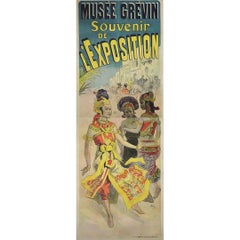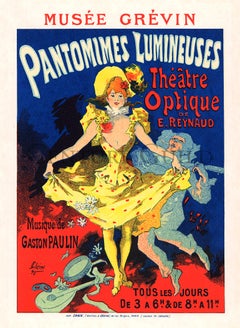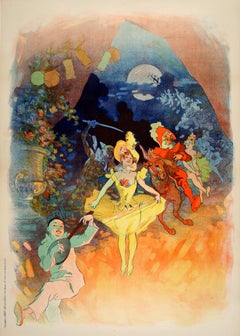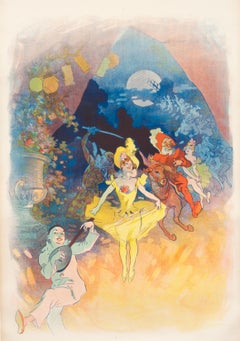Jules Cheret Musee Grevin
Belle Époque original 1890 poster Jules Chéret Musée Grévin colonial exhibition
By Jules Chéret
Located in PARIS, FR
through vivid color, whimsy, and imperial pageantry. Commissioned as a souvenir for the Musée Grévin
Category
1890s Prints and Multiples
Materials
Linen, Paper, Lithograph
$4,066
H 94.1 in W 34.26 in
Musée Grévin : Dancer - Lithograph (Les Maîtres de l'Affiche), 1895
By Jules Chéret
Located in Paris, IDF
Jules Chéret
Musée Grévin : Dancer Lifting Her Skirt, 1895
Stone lithograph
Printed signature in
Category
1890s Art Nouveau Figurative Prints
Materials
Lithograph
$478
H 15.36 in W 11.42 in
Musée Grévin, Pantomimes Lumineuses by Jules Cheret, Commedia lithograph, 1896
By Jules Chéret
Located in Chicago, IL
25 are estimated to have survived to date.
Stone lithograph of Jules Chéret’s Musée Grévin
Category
1890s Art Nouveau Prints and Multiples
Materials
Lithograph
$5,800
H 12.437 in W 8.562 in D 0.2 in
Original Jules Cheret Antique Poster Musee Grevin Paris 1900
By Jules Chéret
Located in Boca Raton, FL
great French artist, Jules Chéret. The poster advertises a show performance at the Musee Grevin in Paris
Category
Early 1900s Prints and Multiples
Materials
Lithograph
$4,400
H 48.5 in W 34.5 in
Original Jules Cheret Antique Poster Musee Grevin Paris 1900
By Jules Chéret
Located in Boca Raton, FL
great French artist, Jules Chéret. The poster advertises a show performance at the Musee Grevin in Paris
Category
Early 1900s Prints and Multiples
Materials
Lithograph
$4,400
H 48.5 in W 34.5 in
Recent Sales
Musée Grévin : Dancer - Lithograph (Les Maîtres de l'Affiche), 1895
By Jules Chéret
Located in Paris, IDF
Jules Chéret
Musée Grévin : Dancer Lifting Her Skirt, 1895
Stone lithograph
Printed signature in
Category
1890s Art Nouveau Figurative Prints
Materials
Lithograph
"Musee Grevin" Original Art Nouveau Cabaret Performance Poster 1900 Cheret
By Jules Chéret
Located in Boston, MA
This is the most famous of several posters Cheret made for the Musee Grevin, a Parisian museum
Category
Early 1900s Art Nouveau Prints and Multiples
Materials
Lithograph
Musée Grevin: Théatre les Fantouches
By Jules Chéret
Located in San Francisco, CA
Grevin. The Musée Grévin is a Paris original: originally a waxworks founded around 1880 by caricaturist
Category
Early 1900s Art Nouveau Figurative Prints
Materials
Lithograph
People Also Browsed
Striking Art Nouveau Ceramic and Bronze-Mounted Vase in Victor Horta Style
By Victor Horta
Located in Lisse, NL
Top condition and pure elegance Art Nouveau vase.
For the collectors of museum quality and condition Art Nouveau ceramics. This stunning Art Nouveau vase is decorated with the mos...
Category
Early 20th Century European Art Nouveau Vases
Materials
Bronze
$2,870
H 10.75 in W 5.25 in D 4.4 in
Art Deco Rabbit, Hare Silver Plated Bronze Bookends, A.E.L, 1920s
By A.E.L.
Located in Buenos Aires, Olivos
Very nice Art Deco rabbit, hare silver plated bronze bookends. Signed A.E.L. , stamped France and 28. Mounted Over Russian Onix.
We have specialized in the sale of Art Deco and Art ...
Category
Early 20th Century French Art Deco Animal Sculptures
Materials
Brass
$1,999 / set
H 6.7 in W 7.09 in D 3.35 in
Art Deco Chandelier
By Sofar
Located in Rebais, FR
Art Deco chandelier with nickel finish and curved glass rod.
Category
21st Century and Contemporary French Art Deco Chandeliers and Pendants
Materials
Brass
Art Deco Dressing Table and Mirror
By Sofar
Located in Rebais, FR
Art Deco dressing table with mirror and sconces.
Category
21st Century and Contemporary French Art Deco Wall Lights and Sconces
Materials
Brass
Art Deco Lamp
By Sofar
Located in Rebais, FR
Art Deco lamp with led in the foot.
Category
21st Century and Contemporary French Art Deco Table Lamps
Materials
Brass
Attributed to Istvan Szonyi
By Istvan Szonyi
Located in Houston, TX
Hungarian Artist (1894-1960)
"Reclining Nude", circa 1920s
Measures: 19.5" H x 23.5" W, overall size is 28" x 32.5"
Oil on canvas, inscribed lower right "Somody baratomnak szere...
Category
Vintage 1920s Hungarian Other Paintings
Materials
Canvas
Gothic Revival Fireplace with its Hood and Carved Salamander, Witch and Ermine
Located in Beuzevillette, FR
Exceptional oak neo-Gothic fireplace and hood. The uprights sides of the fireplace are composed of two columns with capitals foliage patterns, all surmounted by a reserve on which is...
Category
Antique Late 19th Century French Gothic Revival Fireplaces and Mantels
Materials
Oak
$26,309
H 97.64 in W 71.46 in D 22.64 in
20th Century Art Nouveau Revival Italian Sterling Silver Vase
By Ferrari Milano
Located in VALENZA, IT
Sterling silver vase in Art Nouveau - Liberty style made entirely by hand.
The preparation of the structure of the vase required several processing times. The vase was made in differ...
Category
Vintage 1980s Italian Art Nouveau Sterling Silver
Materials
Sterling Silver
English Georgian Mahogany Gadrooned and Upholstered Tester Bed, Circa 1800
Located in Charleston, SC
English Georgian mahogany four-poster bed with a carved molded inset headboard, tapered head post, serpentine gadrooned and upholstered tester with a centered carved urn & swags, dec...
Category
Antique Early 1800s English Georgian Beds and Bed Frames
Materials
Upholstery, Mahogany
$26,000
H 102 in W 61.5 in D 79 in
19th Century Chinese Canopy Wedding Bed
Located in Marbella, ES
This is a wonderful example of a canopy bed from Shanghai Province, China. Made of Chinese Northern Elm, this bed features hoofed feet and multiple floral carvings.
The exterior ...
Category
Antique 19th Century Chinese Beds and Bed Frames
Materials
Gold Leaf
Pair of Jean Perzel Attributed 1940s Gilt Iron Wall Sconces
By Atelier Jean Perzel
Located in Sharon, CT
A pair of very large (27.5 inches high-exclusive of globes) Gilded Cast Iron (21 lbs. each) Wall Sconces. Not signed or otherwise marked.
Category
Vintage 1940s French Art Deco Wall Lights and Sconces
Materials
Iron
Liceu de Artes e Ofícios. 19th Century Daybed
Located in Sao Paulo, SP
This recamier/daybed was conceived and executed with utmost quality and expertise, showing a style that incorporates many influences from the eigtheenth and ninetheenth century. Made...
Category
Antique Late 19th Century Brazilian Romantic Chaise Longues
Materials
Wood
Raymond Subes French Art Deco Steel and Marble Console Table
By Raymond Subes
Located in Queens, NY
French Art Deco steel console table with a verde antico / green marble top and conforming base joined by scrolling apron & legs (Attributed to RAYMOND SUBES)
Category
Vintage 1930s French Art Deco Console Tables
Materials
Marble, Steel
Louis Majorelle French Art Nouveau Walnut and Bronze Wall Mirror
By Louis Majorelle
Located in Queens, NY
French Art Nouveau walnut wall mirror with a beveled glass, two burl walnut top panels, and floral motif gilt bronze trim. (by LOUIS MAJORELLE)
Category
Antique Late 19th Century French Art Nouveau Wall Mirrors
Materials
Bronze
Pair of 1985 Vivienne Westwood Iconic Rocking Horse Shoes
By Vivienne Westwood
Located in New York, NY
Pair of iconic Vivienne Westwood rocking horse ballerina shoes, circa 1985
The shoes are in excellent vintage condition and are a size 8.
Category
Vintage 1980s English Abstract Sculptures
Materials
Leather
Oval Art Deco Chandelier
By Sofar
Located in Rebais, FR
Art Deco chandelier with nickel finish.
Category
21st Century and Contemporary French Art Deco Chandeliers and Pendants
Materials
Bronze
Get Updated with New Arrivals
Save "Jules Cheret Musee Grevin", and we’ll notify you when there are new listings in this category.




